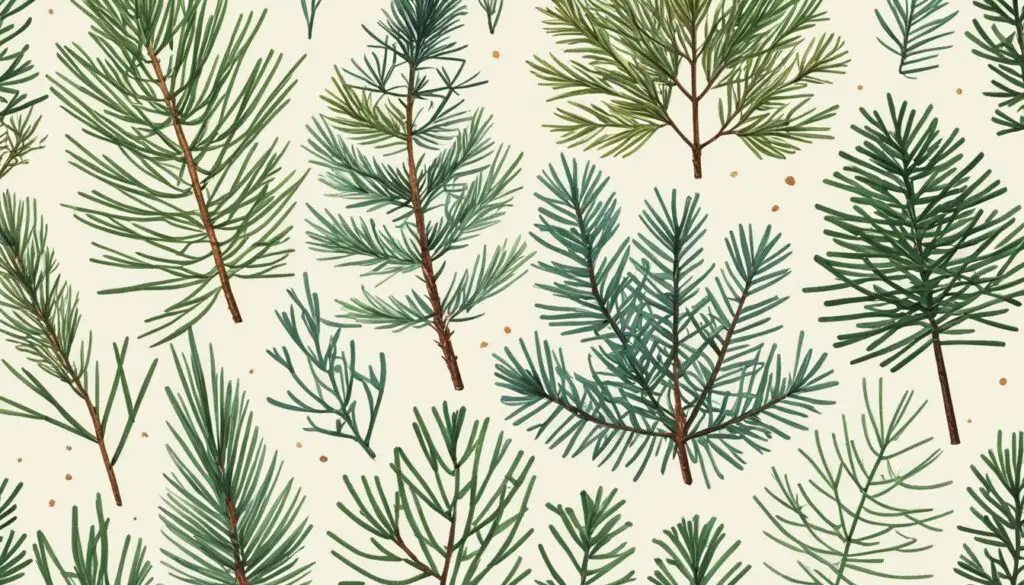Gardening enthusiasts often wonder why their once lush and vibrant pine trees suddenly start turning brown. The sight of discolored pine trees can be worrying, but understanding the causes behind it can help you take effective action to revive their health.
Pine tree discoloration can be attributed to several factors. Environmental issues such as drought and extreme temperatures can cause stress to the trees, resulting in brown needles. Moreover, needle diseases caused by fungi and bacteria can also contribute to the browning of pine trees. Identifying the root cause of the problem is crucial in implementing the right solutions.
Key Takeaways:
- Environmental factors like drought and extreme temperatures can cause pine tree browning.
- Needle diseases caused by fungi and bacteria can also contribute to discoloration.
- Identifying the cause is essential in implementing effective solutions.
- Regular monitoring and evaluation of tree health are important.
- Proper care, disease management, and environmental adjustments can help revive dying pine trees.
Understanding the Plight of Your Pine Trees
Pine trees are not immune to stressors that can lead to browning. Environmental issues like drought, extreme temperatures, poor soil conditions, and excessive sunlight can cause pine trees’ needles to turn brown as a survival mechanism. Additionally, needle diseases caused by fungi and bacteria can affect the needles’ ability to photosynthesize, leading to browning and tree decline.
Protecting your pine trees from turning brown requires a comprehensive understanding of the potential diseases they may face and the environmental factors that contribute to their distress. By identifying and addressing these issues promptly, you can safeguard the health and vitality of your pine trees.
One of the main culprits behind pine tree browning is the prevalence of certain diseases that specifically target the needles. These needle diseases can impact the tree’s ability to thrive, resulting in irreversible damage if left untreated.
“The needles are the lifeblood of pine trees, responsible for vital processes like photosynthesis. When diseases hamper their function, it can have detrimental effects on the overall health of the tree.”
By adopting proactive measures and implementing appropriate treatments, you can effectively mitigate the risk of pine tree diseases and protect your beloved trees from turning brown. Let’s explore some common pine tree diseases and their preventive strategies in the next section.
Quick Course in Identifying Pines
Before addressing pine tree diseases and solutions, it’s important to know how to identify pine trees. Pine trees have unique characteristics that set them apart from other tree species.
Here are some common characteristics of pine trees:
- Pine trees typically have needles arranged in clusters, with the number of needles per cluster varying by species.
- They also have different needle lengths, cone types, and bark textures, which can aid in identification.

Pine trees can be categorized into different species based on these characteristics. Let’s explore some examples:
| Species | Needle Clusters | Needle Length | Cone Type | Bark Texture |
|---|---|---|---|---|
| Lodgepole Pine | 2 needles per cluster | 1.5-3 inches | Serotinous cones | Scaly |
| Ponderosa Pine | 3 needles per cluster | 5-10 inches | Persistent cones | Orange-brown and furrowed |
| White Pine | 5 needles per cluster | 2.5-5 inches | Cylindrical cones | Smooth and gray |
By observing these characteristics and referring to field guides or online resources, you can become proficient in identifying different pine tree species. This knowledge will be valuable in understanding potential diseases and treatments specific to each species.
Pine Tree Diseases: A Comprehensive Overview
Pine trees are susceptible to various needle diseases that can cause browning, wilting, and even death of the needles. Understanding these diseases and their symptoms is crucial for effective management and preservation of pine tree health.
Pine Needle Rust
Pine needle rust, caused by the fungus Cronartium ribicola, is a common disease that affects pine trees. It typically appears as yellow-orange blisters or pustules on the needles, which later turn rusty brown. This rust-colored fungal spore mass can spread through wind dispersal, causing infection in neighboring trees.
Pine Needle Blight
Pine needle blight, caused by the fungus Lophodermium spp., is another common disease that affects the needles of pine trees. Infected needles develop yellow or brown spots, which gradually expand and can merge together. Severe cases may result in complete browning and defoliation of the affected branches.
Dothistroma Needle Blight
Dothistroma needle blight, caused by the fungus Dothistroma septosporum, primarily affects certain pine species, such as Pinus radiata and Pinus ponderosa. Symptoms include the appearance of purplish-black bands or lesions on the needles, often accompanied by yellowing and premature needle drop.
Pine Wilt Disease
Pine wilt disease, caused by the nematode Bursaphelenchus xylophilus, is a devastating disease that affects several pine species. It is primarily transmitted through pine sawyer beetles. Symptoms include wilting, discoloration, and death of the needles and branches, ultimately leading to the rapid decline and death of the entire tree.
Proper diagnosis of these diseases is essential for implementing appropriate management strategies. It is recommended to consult with a professional arborist or tree care specialist to accurately identify the disease and determine the most effective treatment options.
How to Save a Dying Pine Tree
Reviving a dying pine tree requires proper care, disease management, and environmental adjustments. By taking the following steps, you can give your brown pine tree the best chance at recovery:
- Identify the specific problem: First, determine the underlying cause of the browning. It could be due to lack of water, nutrient deficiency, fungal infection, or other factors.
- Prune affected branches: Carefully remove any dead or diseased branches to promote healthy growth and prevent further spread of the problem.
- Apply fungicides: If fungal disease is the culprit, apply appropriate fungicides following the instructions provided. This can help eliminate the infection and protect new growth.
- Improve soil quality: Ensure the soil around the pine tree is well-draining and rich in nutrients. Consider adding organic matter or using fertilizers specifically formulated for pine trees.
- Ensure adequate watering: Proper watering is crucial for pine tree health. Be mindful of the tree’s water needs and adjust irrigation accordingly. Avoid overwatering, as it can lead to root rot.
- Protect from extreme temperatures: Shield the pine tree from harsh weather conditions, such as extreme heat or cold. Providing shade during hot summer days or using protective coverings during winter can help mitigate stress.
- Regular monitoring and evaluation: Keep a close eye on your pine tree’s progress. Regularly assess its health, growth, and the effectiveness of the implemented care measures. Adjust your approach if necessary.
While these steps can help save a dying pine tree, some cases may require professional assistance. If your efforts do not yield positive results, consulting an arborist or tree care specialist is recommended.
Remember, reviving a brown pine tree requires patience and consistent care. By addressing the underlying issues and providing appropriate care, you can give your pine tree the opportunity to recover and thrive once again.

Conclusion
Preventing pine tree browning and addressing common reasons for pine tree discoloration is crucial for maintaining the health and beauty of these iconic trees. By understanding the causes of browning and implementing appropriate solutions, you can ensure the longevity of your pine trees and enjoy their natural splendor for years to come.
In cases where a pine tree cannot be saved despite your best efforts, it is important to prioritize safety by arranging for its safe removal. Additionally, you may consider replacing the tree with a more suitable species that is better adapted to your specific environmental conditions.
With the right knowledge and care, you can protect your pine trees from browning by addressing environmental stressors, managing diseases, improving soil quality, and implementing proper watering techniques. Regular monitoring and evaluation are essential for catching issues early and taking timely action to save your trees.
FAQ
Why do pine trees turn brown?
Pine trees can turn brown due to a variety of reasons, including environmental issues such as drought and extreme temperatures, as well as needle diseases caused by fungi and bacteria.
What are the causes of pine tree browning?
Pine trees can turn brown due to environmental factors like drought, extreme temperatures, poor soil conditions, and excessive sunlight. Needle diseases caused by fungi and bacteria can also lead to browning and tree decline.
How can I prevent my pine trees from turning brown?
To prevent pine tree browning, ensure proper care and environmental adjustments. This includes addressing specific problems causing browning, pruning affected branches, applying fungicides, improving soil quality, ensuring adequate watering, and protecting from extreme temperatures.
What are some common pine tree diseases?
Pine trees can be affected by needle diseases such as pine needle rust, pine needle blight, and dothistroma needle blight. Pine wilt disease caused by nematodes can also lead to rapid tree decline.
How can I save a dying pine tree?
To save a dying pine tree, proper care, disease management, and environmental adjustments are necessary. This includes identifying the specific problem causing browning, pruning affected branches, applying fungicides for fungal diseases, improving soil quality, ensuring adequate watering, and protecting from extreme temperatures.
How can I prevent pine tree browning in the first place?
Understanding the causes of pine tree browning and implementing appropriate solutions, such as proper care and disease management, can help prevent further discoloration and promote the health and longevity of pine trees.

